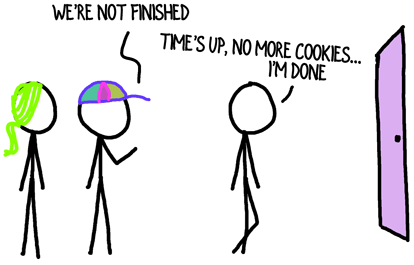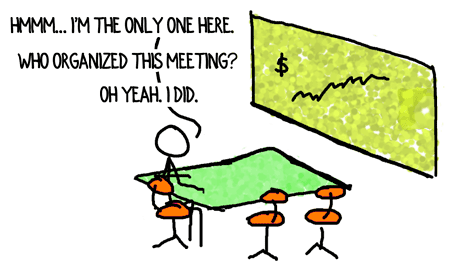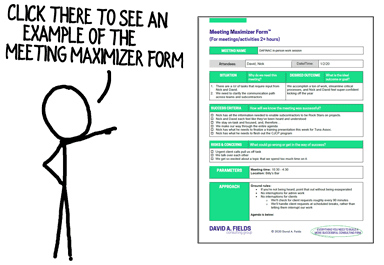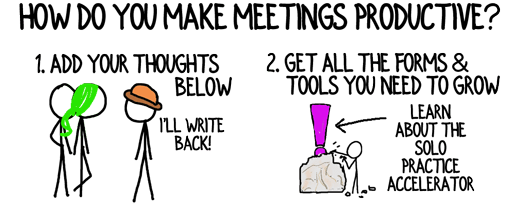Imagine this: You meet with the analyst and subcontractors working on a consulting project, and after a couple of precious hours pass, there are only powdered sugar doughnut holes left in the box and you’ve somehow achieved a disappointing fraction of what you intended.
That’s too easy to imagine, because similar scenarios with different snacks play out every day, right?

Accomplishing too little during a block of time is an especially troublesome problem for consulting firms.
Inefficient work directly affects your consulting firm’s capacity and profitability, and your quality of life.
Fortunately, the Meeting Maximizer Form is impressively effective at improving the power of your internal meetings. (You can use it with your consulting clients too, but start internally.)
Plus, if you’ve practiced writing Context Documents or followed the Perfect Proposal Template with your consulting clients, you’ll find the Meeting Maximizer Form familiar.
Use the form for any meeting or activity scheduled for more than two hours (at one sitting or across multiple meetings). The form also works when the only person at the “meeting” is you; i.e., when you’ve set aside a few hours to work productively.

Five-to-fifteen minutes pounding out a Meeting Maximizer Form will pay off in spades by the time you hit the end of your scheduled time.
The Meeting Maximizer Form
Situation
What’s the catalyst for this meeting? For example, a consulting deliverable is due, a deadline is looming, or you desperately need to revisit the brownie tasting research.
Desired Outcome
How will you and/or your consulting team be better off at the end of this block of time? Be specific. Something like, “The Lizard presentation is complete to at least a B+ level.”
Indicators of Success
These are your goalposts for the meeting, and deserve thoughtful consideration. Powering through the agenda is rarely the only success criteria. Others could range from “Lenny knows what to do next on the Coco Nibs project” to “Every consultant feels like a valuable contributor.”
Your mission during your allocated time is simple: check off every success indicator.
Risks and Concerns
What could go wrong during the meeting? Often this boils down to, “Distractions and interruptions could derail us.” However, you may have other concerns too, such as everyone feeling heard or a key player not showing up.
Parameters
Typically, this just specifies the location. You can specify other parameters though, such as web-conference dial-in information, the language you’ll use, or who’s bringing the hot cocoa.
Approach
Sketch out anything that will help you ace every indicator of success while overcoming the risks and concerns. For instance, in your approach you may want to include:
Ground Rules – e.g., “No interruptions, even for clients,” or “Every discussion must be about the Insurance project,” or “Don’t talk while chewing.”
Agenda – The topics you’ll cover, clearly indicating who owns the agenda item and how much time you’ve allocated to cover it.
Decisions to be Made – Knowing this list in advance will save you and your meeting from wandering aimlessly.
Tools We’ll Use – Any templates, checklists, dashboards etc. that will facilitate your progress during the meeting.
At the start of your meeting, review your Meeting Maximizer Form with attendees and ensure everyone’s in agreement. If you didn’t prepare the form in advance do not write the form collaboratively. Instead, excuse yourself for fifteen minutes to complete the form.
There are, of course, a slew of tactics for improving the effectiveness of your consulting firm’s meetings. The Meeting Maximizer Form is one my team has found particularly helpful.
How do you make internal meetings productive?
Text and images are © 2024 David A. Fields, all rights reserved.

 David A. Fields Consulting Group
David A. Fields Consulting Group 


Thank you for this David! You warn against filing it the form collaboratively. Why’s that?
Great question, Paul. For a four-hour meeting, you could chew up 90 minutes of it (or all four hours) just filling out the form.
Remember, the form’s not a dictate–you should review it at the start of the meeting and get feedback; however, there’s an important (time saving) difference between building the form together from scratch and building a 90%-correct form yourself, then tweaking it with your team.
Thanks for asking the insightful question!